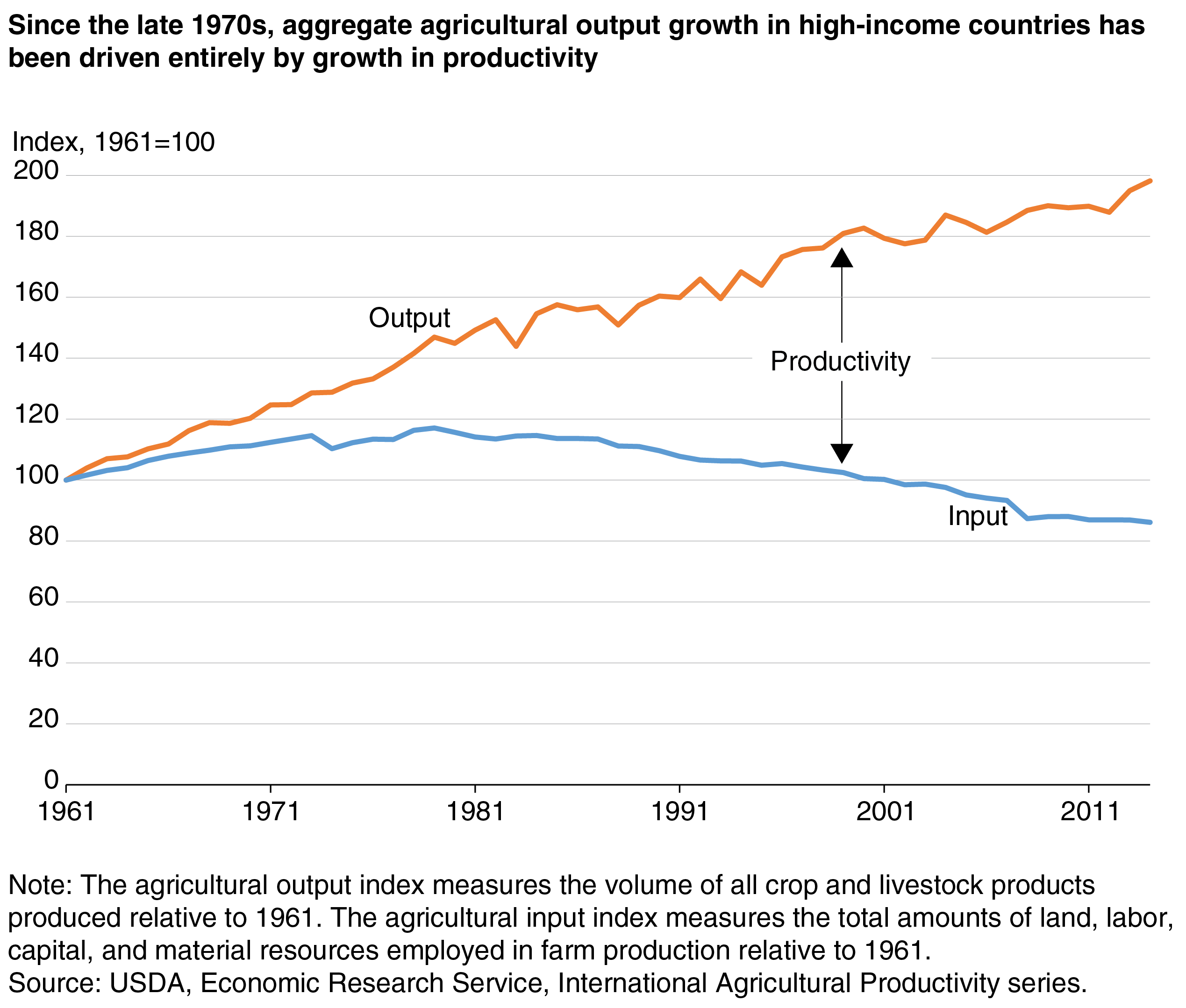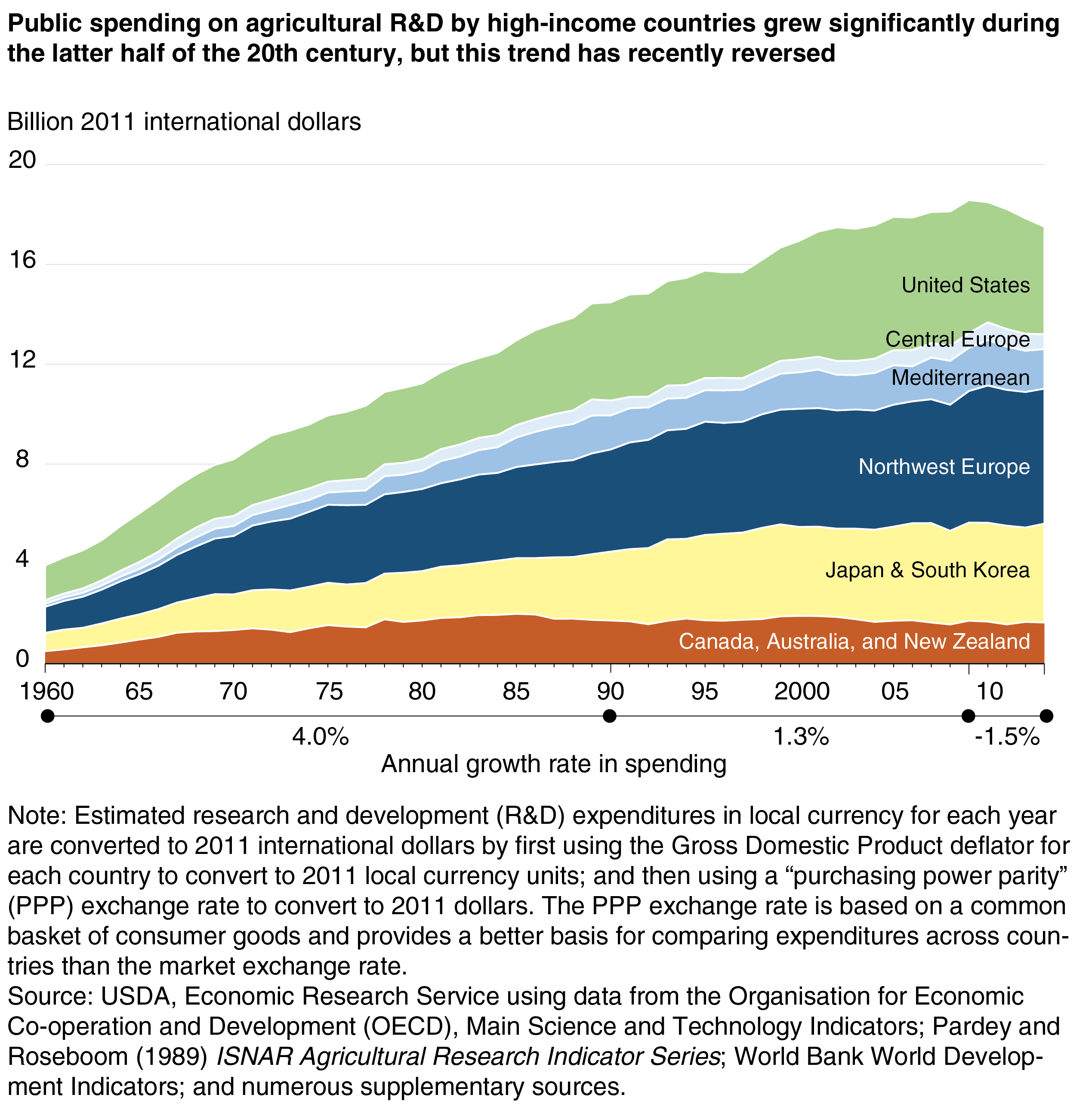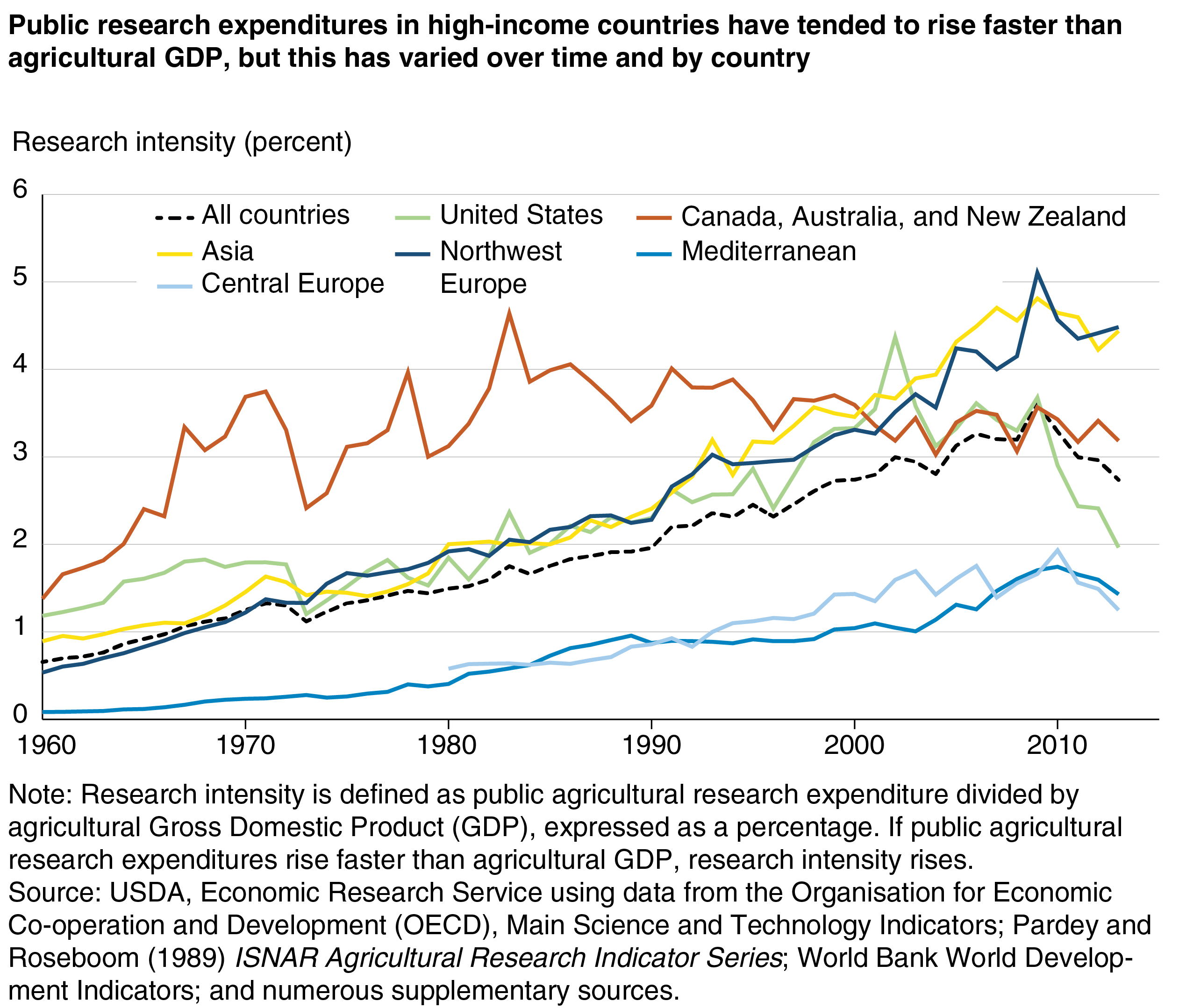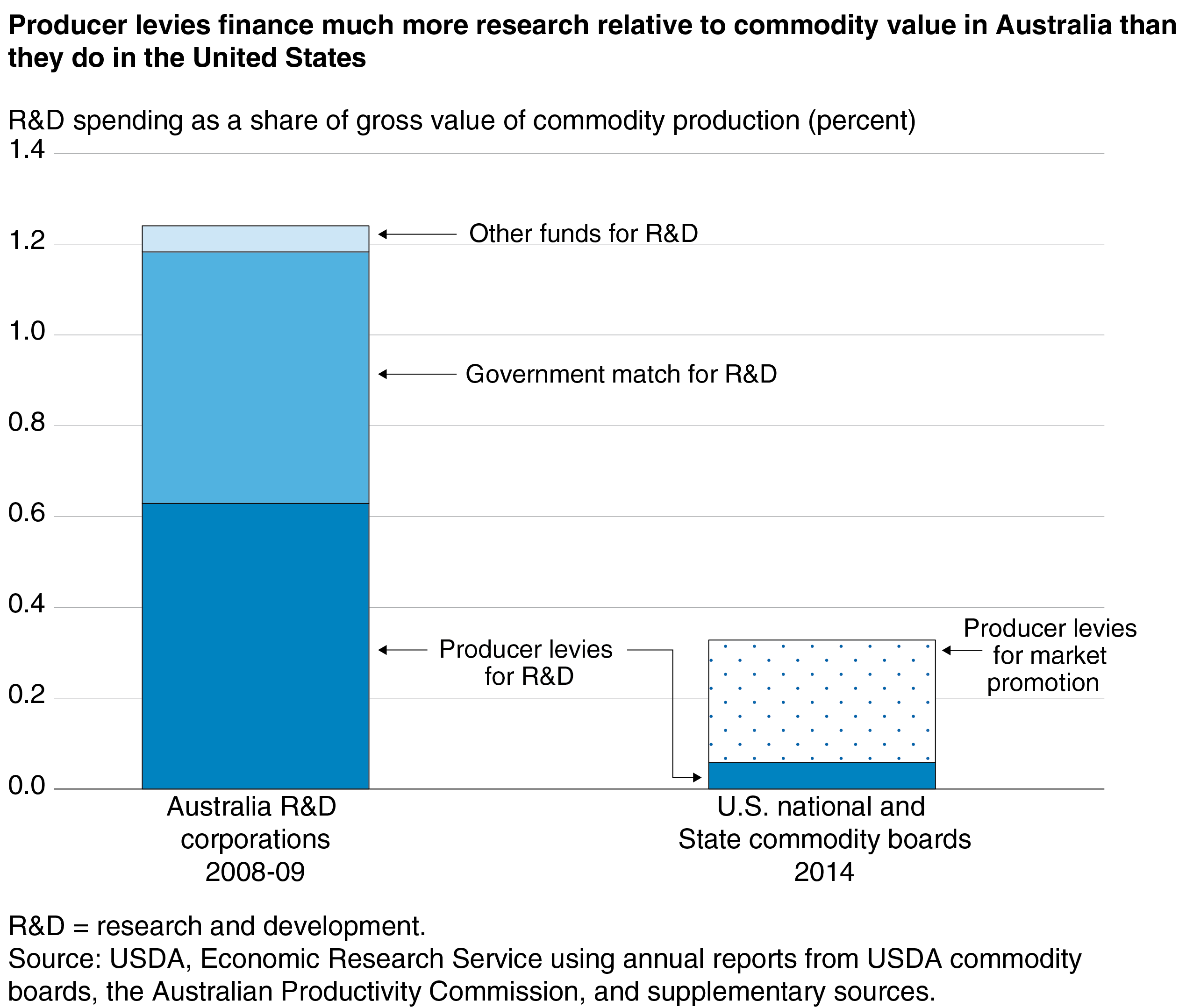
Agricultural Research in High-Income Countries Faces New Challenges as Public Funding Stalls
- by Paul Heisey and Keith Fuglie
- 5/29/2018
Highlights
- Public investment in agricultural research and development (R&D) has been a major driver of long-term agricultural growth in high-income countries, such as the United States, Australia, and France.
- Public spending on agricultural R&D by high-income countries grew significantly during the latter part of the 20th century, but this trend has recently reversed; agricultural R&D investment by this group of countries is now falling in real terms.
- In response to new pressures, some countries have reformed their public agricultural research systems to develop new sources of funding for R&D, accommodate more private-led innovation, and focus more spending on social objectives other than raising productivity, such as environmental protection and food safety.
Investment in research and development (R&D) is a primary driver of productivity growth in agriculture. In high-income countries—such as the United States, Australia, and France—increases in productivity typically account for nearly all growth in agricultural output. Productivity growth may also reduce the amounts of land, labor, capital, or other inputs used in production. Thus, trends in input use generally do not explain trends in agricultural output.
In high-income countries, governments have tended to invest a relatively high proportion of their total public R&D spending in agriculture. One reason is that technological innovations, such as new seeds, are often difficult and expensive to develop—but then comparatively cheap to distribute and copy. This makes it difficult for the innovator to capture all the benefits from the research. A second reason is that farms are generally too small to conduct their own research. Even today’s large farms are mostly small businesses. Further, agricultural growing conditions are highly diverse, so agricultural technologies must adapt to different local needs. Nonetheless, as agricultural Gross Domestic Product (GDP) has shrunk to a small share of national economic output in high-income countries, the proportion of public agricultural R&D in total public spending has followed suit.
Until recently, public spending on agricultural R&D in high-income countries still managed to grow at least as fast, or faster, than agricultural GDP. But this trend reversed in many high-income countries following the global financial crisis of 2008-09. Between 2009 and 2013, after adjusting for inflation, total agricultural R&D spending by these countries fell by almost 6 percent—the first sustained drop in over 50 years.
If this decline in R&D investment continues, the growth of agricultural productivity and output may eventually slow. In response to funding constraints, changing agricultural structure, and other challenges, some countries have introduced reforms to diversify sources of financial support for agricultural research, strengthen incentives for private research, and direct more public research toward broader social objectives.
Public agricultural research has driven agricultural productivity growth in high-income countries
The successful transition from resource-dependent to productivity-led agricultural growth during the latter half of the 20th century largely stemmed from investments in agricultural R&D and the application of industrial inputs in agriculture. Between 1961 and 2014, as shown in the figure below, real agricultural output in high-income countries increased by 98 percent, while total inputs declined by 14 percent. Aggregate total inputs grew slowly until the late 1970s and have declined ever since. The mix of inputs also changed, with capital and material inputs substituting for labor and land. Overall, the growth in agricultural output and the decline in inputs implies that total factor productivity (TFP)—the total productivity of the land, labor, capital, and material inputs employed in production—more than doubled over this 54-year period.
Growth patterns have varied somewhat across high-income countries. In North America (United States and Canada) and Oceania (Australia and New Zealand), productivity growth has primarily raised agricultural output. In Northwest Europe, output growth stagnated in the 1980s, and TFP improvement has led to substantially fewer inputs used in agriculture since then. Southern European/Mediterranean and East Asian (Japan and South Korea) countries have followed a similar pattern to Northwest Europe, except that output continued to grow until the 1990s before leveling off. In all these countries, agricultural TFP has grown steadily. In contrast, Central European transition economies showed little improvement in agricultural TFP during the Communist era, when output closely paralleled input use. Agricultural TFP in these countries has only begun to rise in the last decade.
Public agricultural R&D in high-income countries has had a major impact on agricultural TFP growth. A number of statistical studies have estimated this impact and compared the benefits from productivity improvement to the cost of research investment. In nearly all cases, the economic benefits of TFP growth were several times greater than the costs of the R&D. The estimated benefits to society from public spending on agricultural research compare favorably to other public research investments. A review of 15 studies that estimated returns to public spending on national agricultural research systems in high-income countries found that the average rate of return was 35 percent, varying from a low of 4 percent in Italy to a high of 83 percent in Ontario, Canada. Note that these estimates are social (not private) rates of return, meaning that they include economic benefits to producers, both in the target areas where the research is conducted and elsewhere where the new knowledge may also be applied, as well as to consumers, who benefit from greater food abundance at lower prices. In fact, a key reason why public agricultural R&D has generated such high returns is that it can create large “spillovers,” knowledge that has wide use across different technologies and regions. However, knowledge spillovers may be limited by variation in environmental conditions. For example, agricultural research in temperate countries will have fewer applications in tropical countries, and vice versa—since the kinds of crops grown and production constraints faced by farmers across regions can be very different.
Spillovers can also arise from basic research in other life sciences. For example, U.S. university biomedical research into recombinant DNA technology—followed by research into methods of plant transformation at universities, publicly funded research institutes, and privately funded research institutes across both the U.S. and Europe—was the basis for genetic engineering applied to crops. Improvements in farmer education, greater openness to trade, and farm structural adjustment can also contribute to greater overall efficiency and productivity.
The existence of spillover benefits from public R&D implies that the social rate of return to research (based on its total economic impact) is much higher than its private rates of return (what companies can earn from it). For this reason, private companies tend to underinvest in research, especially in fundamental sciences and pre-commercial science and technology platforms—where spillovers are likely to be especially large. Private companies are also likely to significantly underinvest in applied research that may yield insufficient financial returns, such as research on environmental protection, food safety, and nutrition.
Furthermore, universities and public research institutes in high-income countries conduct much of the path-breaking research that makes major advances in productivity possible. This research may, especially, help to bridge the gaps between discoveries in basic biology and other sciences and their applications to agriculture. A vast majority of the highest ranked universities in agricultural sciences as well as biological sciences are located in high-income countries, particularly in the United States. These universities produce a significant share of the next generation of agricultural scientists for the entire world. Publications from scientists based in high-income countries receive considerably more citations in leading journals than publications elsewhere. In other words, public agricultural science in today’s high-income countries is largely responsible for building global research capacity.
Statistical studies that estimate the rates of return to public agricultural research usually attempt to account for spillovers between industries and across countries. The majority of the evidence suggests that national public R&D, R&D “spill-ins” from other countries, and private R&D have all made substantial contributions to agricultural TFP growth in high-income countries.
After many years of growth, inflation-adjusted spending on public agricultural research has recently fallen in total, as well as relative to agricultural GDP
For high-income countries as a group, public agricultural research expenditures grew rapidly after 1960, but growth slowed markedly in recent decades. In constant 2011 dollars, public agricultural R&D spending in these countries grew from $3.9 billion in 1960 to a peak of $18.6 billion in 2009, before declining to $17.5 billion by 2013 (the latest data available). The decline in real public R&D spending since the global financial crisis of 2008-09 marked the first sustained fall in agricultural R&D investment by these countries in 50 years. The contraction was particularly pronounced in the United States and the Southern Europe/Mediterranean region.
Despite the stagnation in public spending on agricultural R&D, agriculture in these countries continues to receive a relatively large share of total government investment in research and development. In every high-income country studied, public agricultural research intensity—the ratio of public agricultural R&D spending to agricultural GDP—was higher than the ratio of all public R&D spending to national GDP. Several factors help explain the relatively high research intensity of public agricultural R&D. First, public R&D compensates for relatively low private R&D in this sector (which remains true even though private R&D has increased significantly in recent decades). Second, agriculture is a technology-dependent sector—where nearly all growth depends on raising productivity rather than on increasing the use of inputs. Such sectors tend to have larger research intensities than other sectors. Third, governments invest in agricultural R&D to address a range of social objectives other than food production or food security—including environmental protection, food safety and nutrition, and other social issues. The impact of this research is not captured in agricultural GDP.
Although governments spend relatively more public research funds on agriculture than on other sectors of the economy, agriculture’s share of these funds has fallen over time. As agricultural GDP has shrunk to a small share of national economic output—now averaging under 2 percent across all high-income countries—public agricultural R&D spending as a share of total public R&D investment has also fallen. In 1981, agriculture’s share of all public R&D spending in high-income countries was 9.1 percent; by 2013, its share had fallen to 5.2 percent.
Another feature of public investment in agricultural R&D is that, over time, it has tended to rise faster than agricultural GDP. In other words, public agricultural research intensity has trended upward. For high-income countries as a whole, public agricultural research intensity rose from 0.66 percent of agricultural GDP in 1960 to 2.74 percent in 2013. One reason is that, over time, the cost of conducting research has risen faster than the value of agricultural output. In fact, a large part of the declining share of agriculture in national GDP is because of declining terms of trade (i.e., agricultural commodity prices tend to rise more slowly than the prices of all goods and services in the economy).
Another reason may be that as agricultural productivity reaches high levels, a growing share of research spending is needed for “maintenance research,” or research to keep productivity from falling in the face of evolving environmental threats, including new pests and diseases. Some economic models relating agricultural R&D investments to agricultural TFP growth find that when productivity is growing, R&D spending will tend to grow faster than agricultural GDP.
For nearly 50 years, public agricultural research intensities rose across high-income countries as a whole, falling only when aggregate public R&D fell after the global financial crisis of 2008-09. For individual countries or groups of countries, the patterns have been somewhat different. Public agricultural research intensities leveled off or even fell in the agricultural exporting countries of Canada, Australia, and New Zealand starting in the 1980s and in the United States in the early 2000s. Also, research intensities in Southern European/Mediterranean countries and in Central European countries have been consistently lower than those in other high-income countries.
Agricultural R&D policy reforms aim to diversify funding sources, encourage private-sector research, and target broad social objectives
In response to the challenges facing national agricultural R&D systems, several high-income countries have undertaken significant policy reforms. One set of reforms has sought to diversify funding sources for public agricultural research. For example, in the United States, producer levies (or “checkoffs”) are used to raise funds for both research and market promotion. Many of these levies are voluntary (producers can request that levies be refunded), although the 1996 Farm Act provided for mandatory levies as well. In 2014, 19 national and dozens of State producer levies raised about $1 billion in assessments on farm commodity sales. About 18 percent (or $180 million) of these levied funds were allocated to support research, mainly at State agricultural universities.
In the 1980s, Australia enacted a new policy in which the government agreed to match funding of producer levies raised to support agricultural research. Levied and matched funds (capped at 0.5 percent of the gross value of commodity production) were channeled through Research and Development Corporations (RDCs) to be allocated to various research projects conducted by universities and other research institutions. Several commodity groups set levy assessments to obtain the maximum match, and by 1993, producer levies accounted for 18 percent (and 44 percent with matching and other grants raised by the RDCs) of total spending on public agricultural research in Australia.
The matching provision appeared to significantly strengthen the incentive for producers to establish levies to support research. Whereas in Australia, producer levies in 2008/09 amounted to more than 0.6 percent of the gross value of production (GVP), in the United States, total Federal and State producer levies raised less than 0.05 percent of GVP for agricultural research in 2014.
However, levies do not always work as planned. In the 1980s and 1990s, the United Kingdom and the Netherlands enacted reforms to provide for mandatory producer levies for agricultural research. In both countries, public agricultural research funded by commodity boards declined following the reforms, and neither increased research funding using levies. What remains of UK levies is used almost entirely to support extension rather than research. The Netherlands abolished its commodity boards entirely in 2014.
Public agricultural research institutions also diversified funding by seeking support from nontraditional sources that might have an interest in agriculture, such as government agencies with responsibilities for public health, energy, and environment, and general sciences. Nonprofit foundations and private industry were also seen as potentially important sources of funding. In many high-income countries, these alternative sources have become major sources of support of research at agricultural universities and research institutes.
The diversification of research funding sources has tended to shift research away from production-oriented research to other issues, such as food quality and nutrition, food safety, natural resource and environmental conservation, and new uses for agricultural commodities (e.g., biofuel). One study estimates that the share of U.S. public agricultural research expenditures that is oriented toward “farm production” declined from 66 percent in 1975 to 57 percent in 2007.
Another set of reforms encouraged the private sector to take a greater role in funding and conducting research and technology development for agriculture. Increases in private-sector investments in R&D could offset the stagnation in public-sector funding. Many countries strengthened incentives for private R&D in agriculture, such as by providing stronger intellectual property rights (IPR) for biological inventions and innovations and establishing regulatory protocols for the commercialization of biotechnology applications to agriculture.
Partly in response to these incentives, as well as to increased scientific opportunity resulting from fundamental research undertaken by the public sector, research investments by seed and biotechnology companies have increased considerably over the past several decades. As private crop breeding increased, public institutions were able to refocus their efforts on pre-commercial research or on other technology areas not addressed by private firms. However, sorting out the roles for each sector that will lead to the greatest social benefits has required greater coordination between public and private institutions.
In the United Kingdom, reforms in the 1980s that privatized most public plant breeding of field crops led to a significant decline in overall R&D and eventual productivity stagnation. The Netherlands, on the other hand, was more successful in enacting reforms to its public R&D system that successfully stimulated more public-private research collaboration. It merged its government and university agricultural research institutes and established public-private research consortia in the seed and food sectors. The Netherlands continues to have one of Europe’s most competitive food and agricultural sectors and is a major exporter of high-valued crop seed to other countries.
The United States has also experienced considerable growth in private R&D for agriculture. Compared to many other high-income countries, the U.S. has created a more favorable market and regulatory environment for the commercialization of biotechnology traits in crop seed. New crop varieties containing genetically modified traits have become widely adopted in corn, soybean, cotton, canola, sugar beet, and alfalfa. As private crop breeding increased, the number of breeders employed in U.S. public institutions declined. Public breeding programs increasingly focus on pre-commercial research or on crops where the private sector so far has shown limited interest, such as small grains (wheat, barley, etc.).
One potential consequence of the growing importance of the private sector in agricultural R&D is that farmers may face rising prices for inputs like seed. Instead of funding research out of tax dollars, the research costs are increasingly included in the prices paid for new technologies.
Will declining public agricultural research in high-income countries reduce long-term agricultural growth?
Perhaps the most significant issue arising from the downward trend in public spending on agricultural research is what it implies for long-term agricultural growth in high-income countries. So long as (global) market demand for food and agricultural products continues to rise, any slowdown in general agricultural productivity is likely to increase food prices. It will also likely trigger increased pressure on environmental resources (such as converting forests and grasslands to cropland) to meet this growing demand.
But even if the growth in food demand slows, agriculture would continue to need new innovations to maintain present levels of productivity. Changing environmental conditions—a warming climate, declining freshwater resources, soil degradation, the emergence of new pests and diseases—could have significant negative impacts on agriculture. Without a steady stream of new technologies and techniques to address these challenges, agricultural productivity and output could fall.
So far, the decline in agricultural R&D spending by governments in high-income countries has been at least partially offset by increased R&D spending by the private sector and governments in developing countries. But these other sources of R&D are imperfect substitutes for the role that public agricultural R&D institutions in today’s high-income countries have historically performed, for example, in pursuing fundamental advances in agricultural sciences that make major technological innovations possible.
With the diminishing role of public sector research in high-income countries, whether global agricultural productivity can continue to grow enough to meet food and environmental challenges may depend on whether countries like China, India, and Brazil can increase not only the quantity but also the fundamental quality of the work of their public research institutes and universities.
This article is drawn from:
- Heisey, P. & Fuglie, K. (2018). Agricultural Research Investment and Policy Reform in High-Income Countries. U.S. Department of Agriculture, Economic Research Service. ERR-249.
You may also like:
- Fuglie, K., Heisey, P., King, J., Pray, C.E., Day Rubenstein, K., Schimmelpfennig, D., Wang, S.L. & Karmarkar-Deshmukh, R. (2011). Research Investments and Market Structure in the Food Processing, Agricultural Input, and Biofuel Industries Worldwide. U.S. Department of Agriculture, Economic Research Service. ERR-130.
- “R&D Capital, R&D Spillovers, and Productivity Growth in World Agriculture.” Keith Fuglie. (2018). Applied Economic Perspectives and Policy, doi:10.1093/aepp/ppx045.
- “The Evolving Institutional Structure of Public and Private Agricultural Research.” Keith Fuglie and Andrew Toole. (2014). American Journal of Agricultural Economics 96(3): 862-883.
- “Agricultural R&D is on the Move.” Philip G. Pardey, Connie Chan-Kang, Steven P. Dehmer, and Jason M. Beddow. (2016). Nature 537(15 September 2016): 301-303.





